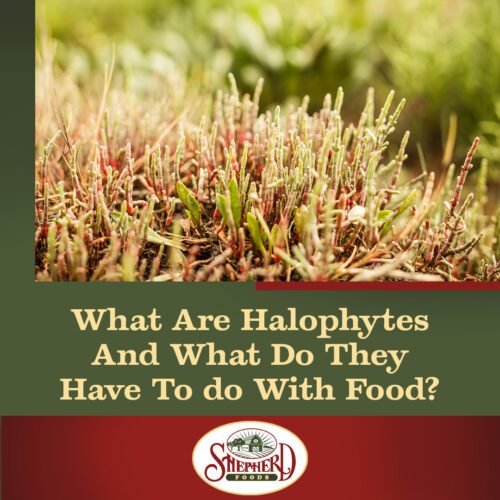 When we think about healthy plants, we usually imagine them growing in fertile soil with plenty of water. However, there are some plants that have adapted to grow in harsh environments with high salt concentrations, called halophytes. There is plenty we can get from these kinds of plants, if not simply some inspiration to adapt to harsh environments and survive.
When we think about healthy plants, we usually imagine them growing in fertile soil with plenty of water. However, there are some plants that have adapted to grow in harsh environments with high salt concentrations, called halophytes. There is plenty we can get from these kinds of plants, if not simply some inspiration to adapt to harsh environments and survive.
Halophytes have unique characteristics that make them valuable for various applications, including, believe it or not, food production! In this blog post, we will explore what halophytes are and how they can be relevant to our food choices, especially as they pertain to the freeze dried food industry.
What are Halophytes?
Simply put, halophytes are plants that have adapted to grow in saline environments. They are found in areas such as coastal regions, salt pans, and salt marshes. These plants have developed unique characteristics that enable them to thrive in high salt concentrations. They have the ability to exclude salt from their roots, tolerate high levels of salt in their tissues, and accumulate salts in their leaves without being damaged.
Examples of Halophytes:
There are many different types of halophytes, and they come in different shapes and sizes. Here are some examples of halophytes that are commonly found in different regions of the world:
Salicornia: also known as sea asparagus, is a halophyte that is commonly found in coastal areas. It is often used in salads, pickled dishes, and as a garnish.
Mangroves: these halophytes are found in both tropical and subtropical regions. They grow in tidal areas and play an important role in protecting coastlines from erosion.
Salsola: also known as tumbleweed, this is a halophyte that is commonly found in arid and semi-arid regions. It is often used as a source of food and fuel in these areas.
Atriplex: also known as saltbush, this is a halophyte that is also commonly found in arid and semi-arid regions. It is often used as a source of food for livestock.
What is the Connection Between Halophytes and Food?
Halophytes are becoming increasingly important for food production, especially in areas with high soil salinity. In these areas, conventional crops cannot grow due to the high salt concentration in the soil. This means that any other troubling variable that enters in this environment has a much heavier impact than areas that could otherwise recover more quickly. However, halophytes can grow easily in these environments, making them a source of much value.
Because of their nature, halophytes are rich in minerals and have a high nutritional value. They contain antioxidants, vitamins, and minerals such as iron, calcium, and potassium. Some halophytes are also high in protein, making them an excellent source of food for people who follow a vegetarian or vegan diet.
In addition to their nutritional value, halophytes can also be used for food preservation. The high salt concentration in halophytes makes them ideal for pickling and curing. Remember the Salicornia that is often pickled and used as a garnish for salads and other dishes.
Halophytes also have potential as a source of biofuel. The high salt concentration in these plants makes them suitable for setting apart for biofuel production since they can be cultivated in more plentiful areas where conventional crops cannot be grown.
The Freeze Drying Industry To Further Revolutionize These Plants
Recent surges in freeze drying technology and popularity have started to shed some new light on these lesser-known organics. Whether people are simply looking for more business ventures in things to freeze dry (we understand!), or nutritionists are pulling from uniquely rich sources to gain more health, halophytes have entered in the freeze drying industry.
The Freeze Drying Process
When food undergoes the freeze drying process, it is at first, of course, flash frozen. Next, the food is put into a lyophilization (or freeze drying) chamber and slowly warmed in a vacuum environment until the moisture sublimates (or changes directly into a vapor) to be removed from the food. The end result is a food ingredient that has effectively had nearly 100% of the moisture removed without damaging the makeup of that food ingredient!
Say Hello To Halophytes
When food is freeze dried, it becomes lightweight and brittle, so to speak. This makes it very easy to reduce the processed food ingredients into a powder for a whole variety of food applications. As some have already put together, this might just take using halophytes as a garnish to a whole new level!
The high salinity and nutritional content of halophytes are being looked at as a new way to approach obtaining salty foods with less sodium and an improved nutritional profile. A study published in this journal was done using a common halophyte as a salt replacement in a cracker recipe. The results were positive and might just lead to further breakthroughs in the food industry. The possibilities are endless!
As our world faces challenges such as soil salinization and climate change, halophytes offer a promising solution. They have the potential to provide food and fuel in areas where conventional crops cannot grow, and they can help to mitigate the effects of climate change. As we continue to explore the potential of halophytes, we may find new and innovative ways to use these unique plants for the benefit of our society and the environment.
Overall, halophytes are a fascinating group of plants that have a lot to offer. They are a reminder that nature has an incredible ability to adapt and thrive in even the harshest environments. By harnessing the potential of halophytes, we can build a more sustainable and resilient future for ourselves and the planet.
You Too Can Gain From The Freeze Drying Industry
If you have developed a sudden interest in halophytes, or have seen some value for your business in the freeze drying industry, contact Shepherd Foods today. As a leader in the freeze drying industry for over 30 years, we can help provide your business with top quality freeze dried food ingredients for a whole array of applications.
If you want to know more about how our professional co-packing and co-manufacturing services can help your business provide excellent products to your consumers, give us a call today at (800) 497-8321.


